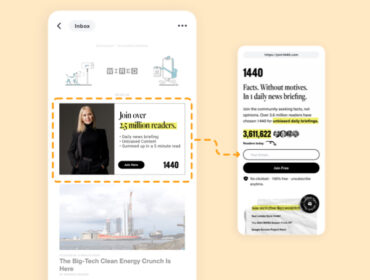LiveIntent retail media market report finds nearly 50% of marketers frustrated by lack of retail media inventory
Advertisers want more retailer inventory, including email newsletters and receipts, and retailer’s branded videos
LiveIntent, a leading marketing and advertising technology company, today announced the second batch of findings from its four-part research project on retail media network (RMN) adoption in digital advertising.
The report, “The 2023 Retail Media Market Report: Unlocking Adoption, Mastering Best Practices, Overcoming Challenges & Driving Performance,” surveyed more than 200 U.S. marketers to examine their experiences and views on the expanding retail media landscape.
Emarketer projects that retail media ad spend in the U.S. will grow by over one-quarter this year, surpassing $51 billion. Considering this, LiveIntent’s four-part research project surveyed 200-plus marketers on four key areas: 1) retail media adoption and performance; 2) potential value of retail media networks; 3) first-party data and retail media; and 4) the opportunity to utilize logged-in media channels, such as social and email, to enhance retail media value.
Part One of LiveIntent’s research, released earlier this month, found that 63% of marketers rank retail media advertising as more effective than other digital channels, and nearly three-quarters (73%) plan to increase investment in 2023, among other findings.
For Part Two, LiveIntent focused on the potential value of retail media networks. A key finding from LiveIntent’s study reveals one of the greatest challenges advertisers face with retail media is – they simply do not have enough of it. In fact, nearly half (47%) of advertisers are frustrated by the scale, complaining there is limited premium inventory.
“Marketers have clearly expressed that retail media inventory is too limited, especially given the high performance of retail media,” said Mike Pisula, VP of Product Development at LiveIntent. “For this category to continue growing and succeeding, retailers need to offer a wider variety of addressable inventory with targetable audiences and improved measurement, including incrementality to secure dollars. Owned and operated email is a crucial part of that shift.”
Additional key insights from LiveIntent’s research include:
RMN Needs
- Advertisers want retail media networks to be logged-in: 61% of advertisers want inventory that is logged-in, like email newsletters and alerts, video/streaming or social media. This reflects what advertisers know: logged-in environments provide access to real, fraud-free inventory and audiences, and are also protected from the impact of cookie deprecation on the open web. Additionally, 61% of advertisers want to use RMNs primarily for discounts and deals. Other advertisers prioritized relevant and useful search ads in RMNs (59%), the ability to target ads based on customer browsing history within an RMN (58%), and integrating with extended reality technologies like AR and VR (43%).
- Advertisers want retail media inventory that goes beyond simply “ads on site”: Advertisers want more video (64%), connected TV/streaming (57%), off-site media (56%), and email-based newsletters, alerts, and receipts (54%) from retail media networks.
- Nearly half of advertisers think RMN should open up ALL of their inventory: When asked if retailers should monetize their inventory through advertising, 96% of respondents agreed. Among them, 46% supported advertising across all channels, including in-store; 27% preferred advertising only in email newsletters, alerts, and receipts; and 24% agreed with advertising just on the site.
- When asked to share their wish list for retail media, advertisers responded that:
- 58% want ads within the digital receipts that are emailed to customers
- 55% want ads within the email newsletters of retailers
- 53% want retargeting within the retailer’s site tied to intent
- 50% want top results in search online
- 47% want ads within product demonstration videos
- 34% want inventory on physical receipts in-store
RMN Challenges
- Retail media doesn’t have enough logins, so measuring the effectiveness of running ads in retail media networks is hard: 44% of advertisers mentioned difficulty measuring campaign effectiveness, a byproduct of the fact that so few people log in to retail media networks today. Other challenges were: more than half (52%) pointed to a lack of awareness among brands and retailers, and 42% cited insufficient sales sophistication and infrastructure among retailers.
RMN Benefits
- Retail media is better for branding and reach than performance: In terms of how RMNs could benefit their brand, 60% said it helps build brand awareness (top of the funnel), 25% said it drives performance advertising outcomes (lower funnel), 9% said it could generate data to replace third-party cookies, and 6% were unsure of the impact.
- Is the value for retailers the immediate sales and revenue, or the creation of first-party data they can use for the end of the third-party cookie? 70% of advertisers believe retail media networks could increase customer engagement and sales for the retailers themselves, 65% think it can provide new revenue opportunities for advertising and sponsorship for the retailers themselve, 56% feel it can build up first-party data for personalization and resolution for the retailers themselve, 55% said it can help track and anticipate inventory demand, and 45% thought retail media networks can build first-party data as third-party cookies disappear.
- Consumers will benefit from retail media networks IN REAL LIFE: Besides relevant advertising (73%), 56% of those surveyed believe it will lead to more useful deal offers, and 68% think it is the key to personalization. Additionally, by tying the online to offline via an identity graph built by first-party data, 59% of respondents think retail media can produce a better in-store shopping experience
“Another challenge is how to grow the total investment from marketers, which entails tapping into national or non-endemic budgets,” added Pisula. “Retailers are currently doing this for their on-site media programs as the click will redirect to a brand page, not a product detail page. However, a retailer with an ‘all-of-the-above’ approach can access these budgets by deploying a sophisticated media strategy that combines on-site, off-site, email, and audience to meet brand needs.”
About LiveIntent:
LiveIntent, one of the world’s largest people-based marketing platforms, connects 2,500 publishing and advertising brands with over 240MM verified people every month across all types of media. With the hashed email address at the center of its industry-leading identity graph, LiveIntent provides brands with solutions that help them monetize, acquire, and retain real people, even where cookies don’t work. LiveIntent enriches a brand’s data, making it possible for them to deepen their understanding of their audiences, and more effectively market to people wherever they are present and paying attention. LiveIntent is home to over 200 people worldwide with offices in New York, Berlin, and Copenhagen.


